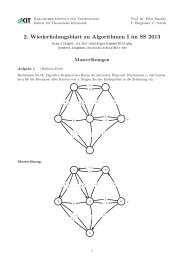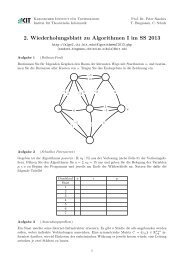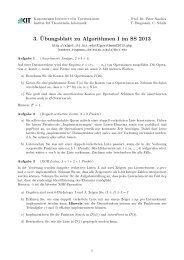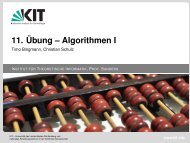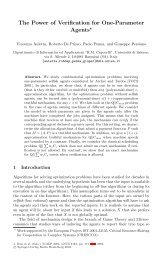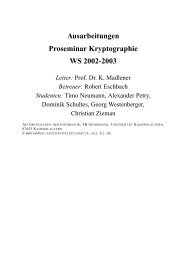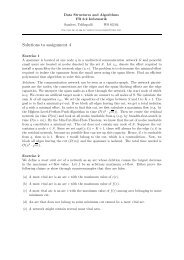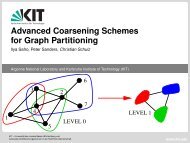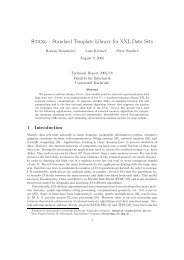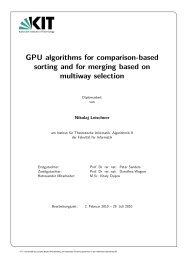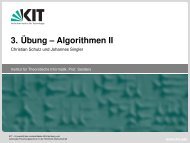Highway Hierarchies Hasten Exact Shortest Path Queries
Highway Hierarchies Hasten Exact Shortest Path Queries
Highway Hierarchies Hasten Exact Shortest Path Queries
Create successful ePaper yourself
Turn your PDF publications into a flip-book with our unique Google optimized e-Paper software.
<strong>Highway</strong> <strong>Hierarchies</strong> <strong>Hasten</strong><br />
<strong>Exact</strong> <strong>Shortest</strong> <strong>Path</strong> <strong>Queries</strong><br />
Peter Sanders 1,⋆ and Dominik Schultes 1,2<br />
1 Universität Karlsruhe (TH), 76128 Karlsruhe, Germany<br />
sanders@ira.uka.de<br />
2 Universität des Saarlandes<br />
mail@dominik-schultes.de<br />
Abstract. We present a new speedup technique for route planning that<br />
exploits the hierarchy inherent in real world road networks. Our algorithm<br />
preprocesses the eight digit number of nodes needed for maps of<br />
the USA or Western Europe in a few hours using linear space. <strong>Shortest</strong><br />
(i.e. fastest) path queries then take around eight milliseconds to produce<br />
exact shortest paths. This is about 2 000 times faster than using<br />
Dijkstra’s algorithm.<br />
1 Introduction<br />
Computing shortest paths in graphs (networks) with nonnegative edge weights<br />
is a classical problem of computer science. From a worst case perspective, the<br />
problem has largely been solved by Dijkstra in 1959 [1] who gave an algorithm<br />
that finds all shortest paths from a starting node s using at most m + n priority<br />
queue operations for a graph G =(V,E) withn nodes and m edges.<br />
However, motivated by important applications (e.g., in transportation networks),<br />
there has recently been considerable interest in the problem of accelerating<br />
shortest path queries, i.e., the problem to find a shortest path between a<br />
source node s and a target node t. In this case, Dijkstra’s algorithm can stop as<br />
soon as the shortest path to t is found.<br />
A classical technique that gives a constant factor speedup is bidirectional<br />
search which simultaneously searches forward from s and backwards from t until<br />
the search frontiers meet. All further speedup techniques either need additional<br />
information (e.g., geometry information for goal directed search) orprecomputation.<br />
There is a trade-off between the time needed for precomputation, thespace<br />
needed for storing the precomputed information, and the resulting query time.<br />
In Section 1 we review existing precomputation approaches, which have made<br />
significant progress, but still fall short of allowing fast exact shortest path queries<br />
in very large graphs.<br />
In particular, from now on we focus on shortest paths in large road networks<br />
where we use ‘shortest’ as a synomym for ‘fastest’. The graphs used for North<br />
⋆ Partially supported by DFG grant SA 933/1-2.<br />
G.S. Brodal and S. Leonardi (Eds.): ESA 2005, LNCS 3669, pp. 568–579, 2005.<br />
c○ Springer-Verlag Berlin Heidelberg 2005
<strong>Highway</strong> <strong>Hierarchies</strong> <strong>Hasten</strong> <strong>Exact</strong> <strong>Shortest</strong> <strong>Path</strong> <strong>Queries</strong> 569<br />
America or Western Europe already have around 20 000 000 nodes so that significantly<br />
superlinear preprocessing time or even slightly superlinear space is<br />
prohibitive. To our best knowledge, all commercial applications currently only<br />
compute paths heuristically that are not always shortest possible. The basic idea<br />
of these heuristics is the observation that shortest paths “usually” use small roads<br />
only locally, i.e., at the beginning and at the end of a path. Hence the heuristic<br />
algorithm only performs some kind of local search from s and t and then switches<br />
to search in a highway network that is much smaller than the complete graph.<br />
Typically, an edge is put into the highway network if the information supplied<br />
on its road type indicates that it represents an important road.<br />
Our approach is based on the idea to compute exact shortest paths by defining<br />
the notion of local search and highway network appropriately. This is very<br />
simple. We define local search to be a search that visits the H closest nodes from<br />
s (or t) whereH is a tuning parameter. This definition already fixes the highway<br />
network. An edge (u, v) ∈ E should be a highway edge if there are nodes s and t<br />
such that (u, v) is on the shortest path from s to t, v is not within the H closest<br />
nodes from s, andu is not within the H closest nodes from t. Section 2 gives a<br />
more formal definition of the basic concepts used in this paper.<br />
One might think that an expensive all-pairs shortest path computation is<br />
needed to find the highway network. However, in Section 3 we show that each<br />
highway edge is also within some local shortest path tree B rooted at some s ∈ V<br />
such that all leaves of B are “sufficiently far away” from s.<br />
So far, the highway network still contains all the nodes of the original network.<br />
However, we can prune it significantly: Isolated nodes are not needed. Trees<br />
attached to a biconnected component can only be traversed at the beginning<br />
and end of a path. Similarly, paths consisting of nodes with degree two can be<br />
replaced by a single edge. The result is a contracted highway network that only<br />
contains nodes of degree at least three. We can iterate the above approach, define<br />
local search on the highway network, find a “superhighway network”, contract<br />
it,...We arrive at a multi-level highway network — a highway hierarchy.<br />
Section 4 develops a query algorithm that uses highway hierarchies. After<br />
several correctness preserving transformations we get a bidirectional, Dijkstralike<br />
search in a single graph that contains all levels. The only modifications affect<br />
the selection of edges to be relaxed and how to finish the search when the search<br />
frontiers from s and t meet.<br />
In Section 5 we summarise experiments using detailed road networks for Western<br />
Europe and the USA. Using a uniform neighbourhood size of 125 and 225 respectively,<br />
the graphs shrink geometrically from level to level. This leads to preprocessing<br />
time around four hours and average query times below 8 ms. Possible future<br />
improvements are discussed in Section 6. Proofs and additional experimental data<br />
can be found in the full version at http://www.dominik-schultes.de/hwy/.<br />
Related Work<br />
There is so much literature on shortest paths and preprocessing that we can<br />
only highlight selected results that help to put our results into perspective. In<br />
the following, speedup refers to the acceleration compared to the unidirectional
570 P. Sanders and D. Schultes<br />
variant of Dijkstra’s algorithm that stops when the target is found. For recent,<br />
more detailed overviews we refer to [2,3].<br />
Perhaps the most interesting theoretical results on route planning are algorithms<br />
for planar graphs that might be adaptable to route networks since those<br />
are ”almost planar. Using O(n log 3 n) space and preprocessing time, query time<br />
O( √ n log n) can be achieved [4] for directed planar graphs without negative cycles.<br />
<strong>Queries</strong> accurate within a factor (1 + ɛ) can be answered in near constant<br />
time using O((n log n)/ɛ) space and preprocessing time [5]. However, for very<br />
large graphs we need linear space consumption so that these approaches seem<br />
not directly applicable to the problem at hand.<br />
The previous practical approach closest to ours is the separator based multilevel<br />
method [6]. The idea is to partition the graph into small subgraphs by<br />
removing a (hopefully small) set of separator nodes. These separator nodes together<br />
with edges representing precomputed paths between them constitute the<br />
next level of the graph. <strong>Queries</strong> then only need to search in the partitions of<br />
s and t and in the higher level graph. This process can be iterated. At least<br />
for road networks speedups so far seem to be limited to a factor around ten<br />
whereas better speedup can be observed for railway transportation problems [6].<br />
Disadvantages compared to our method are that performance depends on very<br />
small (and thus hard to find) separators and that the higher level graphs get<br />
quite dense so that going to many levels quickly reaches a point of diminishing<br />
return. In contrast, our method has a very simple definition of what constitutes<br />
the higher level graphs and our higher level graphs remain sparse.<br />
Reach based routing [7] excludes nodes from consideration if they do not<br />
contribute to any path long enough to be of use for the current query. Speedups<br />
up to 20 are reported for graphs with about 400 000 nodes using about 2 hours<br />
preprocessing time. Our method is an order of magnitude faster both in terms<br />
of query time and in terms of preprocessing time.<br />
Most other preprocessing techniques are different from our approach in that<br />
they focus the search towards the target. Very high speedups (hundreds or even<br />
around 2000) are reported for geometric containers [8,3] and bit vectors [9,10].<br />
Both methods store information with each edge. <strong>Queries</strong> use this information to<br />
decide whether this edge can possibly lead to the target. Our method achieves<br />
similar speedups but needs much less time for preprocessing: To compute kbit<br />
vectors, O( √ kn) global shortest path searches are needed (assuming planar<br />
graphs) and geometric containers even need an all-pairs computation.<br />
An interesting alternative are landmark based lower bounds for strengthening<br />
goal directed search [2]. For global queries, about 16 global shortest path computations<br />
during preprocessing suffice to achieve speedup around 20. However,<br />
the landmark method needs a lot of space — one distance value for each nodelandmark<br />
pair. It is also likely that for real applications each node will need to<br />
store distances to different sets of landmarks for global and local queries. Hence,<br />
landmarks have very fast preprocessing and reasonable speedups but consume<br />
too much space for very large networks.
2 Preliminaries<br />
<strong>Highway</strong> <strong>Hierarchies</strong> <strong>Hasten</strong> <strong>Exact</strong> <strong>Shortest</strong> <strong>Path</strong> <strong>Queries</strong> 571<br />
We expect an undirected graph G =(V,E) withn nodes and m edges with<br />
nonnegative weights as input. 1 We assume w.l.o.g. that there are no self-loops,<br />
parallel edges, or zero weight edges in the input — they could be dealt with easily<br />
in a preprocessing step. The length w(P )ofapathP is the sum of the weights of<br />
the edges that belong to P . P ∗ = 〈s,...,t〉 is a shortest path if there is no path<br />
P ′ from s to t such that w(P ′ )
572 P. Sanders and D. Schultes<br />
t ∈ V with the property that v �∈ NH(s) andu�∈ NH(t). The set V1 is the<br />
maximal subset of V such that G1 contains no isolated nodes.<br />
The 2-core of a graph is the maximal vertex induced subgraph with minimum<br />
degree two. A graph consists of its 2-core and attached trees, i.e., trees whose<br />
roots belong to the 2-core, but all other nodes do not belong to it. A line in a<br />
graph is a path 〈u0,u1,...,uk〉 where the inner nodes u1,...,uk−1 have degree<br />
two. From the highway network G1 of a graph G, thecontracted highway network<br />
G ′ 1 of the graph G is obtained by taking the 2-core of G1 and, then, removing the<br />
inner nodes of all lines 〈u0,u1,...,uk〉 and replacing each line by an edge (u0,uk).<br />
Thus, the highway network G1 consists of the contracted highway network (or<br />
short, just core) G ′ 1 and some components, where ‘component’ is used as a generic<br />
term for ‘attached tree’ and ‘line’. In this paper, ‘components’ is used always in<br />
this specific sense and not to denote ‘connected components’ in general.<br />
The highway hierarchy is obtained by applying the process that leads from<br />
G to G ′ 1 iteratively. The original graph G0 := G ′ 0<br />
:= G constitutes Level 0 of the<br />
highway hierarchy, G1 corresponds to Level 1, the highway network G2 of the<br />
graph G ′ 1 is called Level 2, and so on.<br />
3 Construction<br />
For each node s0 ∈ V , we compute and store the value dH(s0). This can be easily<br />
done by a Dijkstra search from each node s0 that is aborted as soon as H nodes<br />
have been settled. Then, we start with an empty set of highway edges E1. For<br />
each node s0, two phases are performed: the forward construction of a partial<br />
shortest path tree B and the backward evaluation of B. The construction is done<br />
by a single source shortest path (SSSP) search from s0; during the evaluation<br />
phase, paths from the leaves of B to the root s0 are traversed and for each edge<br />
on these paths, it is decided whether to add it to E1 or not. The crucial part is<br />
the specification of an abort criterion for the SSSP search in order to restrict it<br />
to a ‘local search’.<br />
Phase 1: Construction of a Partial <strong>Shortest</strong> <strong>Path</strong> Tree. A Dijkstra search from<br />
s0 is executed. During the search, a reached node is either in the state active<br />
or passive. The source node s0 is active; each node that is reached for the first<br />
time (insert) and each reached node that is updated (decreaseKey) adopts the<br />
activation state from its (tentative) parent in the shortest path tree B. Whena<br />
node p is settled using the path 〈s0,s1,...,p〉, thenp’s state is set to passive if<br />
|N(s1) ∩N(p)| ≤1. When no active unsettled node is left, the search is aborted<br />
and the growth of B stops.<br />
Phase 2: Selection of the <strong>Highway</strong> Edges. During Phase 2, all edges (u, v) are<br />
added to E1 that lie on paths 〈s0,...,u,v,...,t0〉 in B with the property that<br />
v �∈ N(s0)andu�∈ N(t0), where t0 is a leaf of B. This can be done in time O(|B|).<br />
Theorem 1. An edge (u, v) ∈ E is added to E1 by the construction algorithm iff<br />
it belongs to some canonical shortest path P = 〈s,...,u,v,...,t〉 and v �∈ N(s)<br />
and u �∈ N(t).
<strong>Highway</strong> <strong>Hierarchies</strong> <strong>Hasten</strong> <strong>Exact</strong> <strong>Shortest</strong> <strong>Path</strong> <strong>Queries</strong> 573<br />
Speeding Up Construction. An active node v is declared to be a maverick if<br />
d(s0,v) >f·dH(s0), where f is a parameter. When all active nodes are mavericks,<br />
the search from passive nodes is no longer continued. This way, the construction<br />
process is accelerated and E1 becomes a superset of the highway network. Hence,<br />
queries will be slower, but still compute exact shortest paths. The maverick factor<br />
f enables us to adjust the trade-off between construction and query time.<br />
Theorem 2. The highway network can be contracted in time O(m + n).<br />
<strong>Highway</strong> Hierarchy. The result of the contraction is the contracted highway<br />
network G ′ 1, which can be used as input for the next iteration of the construction<br />
procedure in order to obtain the next level of the highway hierarchy.<br />
4 Query<br />
The highway hierarchy G =(V, E) consists of the graphs G0,G1,G2,...,GL,<br />
which are arranged in L+1 levels. For each node v ∈ V and each i ∈{j | v ∈ Vj},<br />
there is one copy of v, namelyvi, that belongs to level i of G. Accordingly, there<br />
are several copies of an edge (u, v) whenuand v belong to more than one<br />
common level. These edges, which connect two nodes in the same level, are<br />
called horizontal edges. Additionally, G contains a directed edge (vℓ,vℓ+1) for<br />
each pair vℓ ∈ Vℓ,vℓ+1 ∈ Vℓ+1, wherevℓand vℓ+1 are copies of the same node v.<br />
These additional edges are called vertical and have weight 0. For each node v,<br />
not only one value dH(v) is known, but for each level ℓ
574 P. Sanders and D. Schultes<br />
2. Components are never entered using a horizontal edge. An edge (u, v) enters<br />
a component if either u belongs to the core and v to a component or u belongs<br />
to a line and v to an attached tree. However, an edge from an attached tree<br />
to a line leaves the attached tree and does not rank among the edges that<br />
enter a component. Note that the endpoint(s) of a component do not belong<br />
to the component but to the core (or to the line in case of the root of a tree<br />
that is attached to a line).<br />
Theorem 3. For any given s, t ∈ V , the multilevel query algorithm finds the<br />
shortest path from s to t in G.<br />
Proof Idea. It is known that the bidirectional version of Dijkstra’s algorithm<br />
works correctly. We have to show that the imposed restrictions do not affect the<br />
correctness. When Restriction 1 applies, it is always possible to switch to the<br />
next level using a vertical edge. Due to the definition of the highway network,<br />
it is guaranteed that the corresponding part of the shortest path which we are<br />
looking for can be found in the next level. A path from s that enters acomponent<br />
is not traversed due to Restriction 2. However, from the point of view of t, this<br />
path leaves the component so that the edge that has been skipped during the<br />
search from s can be relaxed in the reverse direction during the search from t.<br />
Hence, the path can be found in spite of Restriction 2. These arguments can be<br />
used in an inductive proof over the number of levels. �<br />
Collapse of the Vertical Dimension. So far, we allow that several copies of the<br />
same node are reached. However, it can beshownthatitissufficientifatmost<br />
one copy of a node is reached via a horizontal edge, namely the copy with the<br />
smallest tentative distance or, if there are several copies with the same smallest<br />
tentative distance, the copy in the lowest level.<br />
Due to this observation, we can let the vertical dimension collapse. We can<br />
interpret the highway hierarchy G as one plain graph, i.e., there are no copies of<br />
the nodes distributed over several levels. Basically, this graph corresponds to the<br />
original graph G enhanced by some additional data: each edge (u, v) is assigned<br />
a maximum level ℓ(u, v), i.e., it belongs to the levels 0, 1,...,ℓ(u, v); each node v<br />
is assigned to at most one component c(v); a component c(v) belongs to a certain<br />
level ℓ(c(v)), which is equal to the level its inner edges belong to. Furthermore,<br />
the value dℓ H (v) isstoredonlyifv∈G′ ℓ . Our implementation is based on this<br />
interpretation of G.<br />
Abort-on-Success. In the bidirectional version of Dijkstra’s algorithm, we can<br />
abort as soon as both search scopes meet, i.e., there is one node v that is settled<br />
in both search scopes. Then, the shortest path P from s to t does not necessarily<br />
consist of the shortest paths from s to v and from v to t, but it is well known that<br />
it is always ensured that the right meeting point v ′ has already been reached<br />
from both sides. The crucial precondition for this fact is that all nodes whose<br />
distance from s is less than d(s, v) have been settled in the search scope of s,<br />
and all nodes whose distance from t is less than d(t, v) have been settled in the<br />
search scope of t.
<strong>Highway</strong> <strong>Hierarchies</strong> <strong>Hasten</strong> <strong>Exact</strong> <strong>Shortest</strong> <strong>Path</strong> <strong>Queries</strong> 575<br />
Unfortunately, we cannot adopt the abort-on-success criterion as it stands<br />
because, in general, the multilevel query algorithm does not fulfil this precondition<br />
as several edges are not relaxed due to Restriction 1 and 2 so that we cannot<br />
guarantee that all nodes up to a certain distance have been settled. We have already<br />
shown that the algorithm is correct all the same because if an ‘important’<br />
edge is not relaxed (e.g. a component is not entered), then it is relaxed from the<br />
other side (e.g. the component is left). However, we have to wait until the reverse<br />
search has relaxed this edge, i.e., we must not abort too early. Nevertheless, even<br />
if we have skipped an edge e =(u, v) atnodeu, wecan abort after both search<br />
scopes have met as soon as it is certain that e will not be relaxed from v during<br />
the final steps of the search. We can use the following approach. Let Es denote<br />
the set of all horizontal edges that have been skipped during the search from s.<br />
Et is defined accordingly. After both search scopes have met, we can abort as<br />
soon as the search from t has finished search level ˆ ℓs := maxe∈Es ℓ(e) andthe<br />
search from s has finished level ˆ ℓt := maxe∈Et ℓ(e). A search level ℓ is finished<br />
when there are no reached but unsettled nodes in level ℓ or below. If the search<br />
level ℓ is finished, edges e in levels ℓ(e) ≤ ℓ cannot be relaxed any longer. Hence,<br />
when the search from t has finished search level ˆ ℓs, it is certain that no edge<br />
e that belongs to a level ℓ(e) ≤ ˆ ℓs will be relaxed during the final steps of the<br />
search, in particular, no edge that has been skipped during the search from s will<br />
be traversed by the backward search. There are several possibilities to further<br />
improve this abort criterion, which are described in the full paper.<br />
5 Experiments<br />
Implementation. We use a binary heap priority queue. Our current implementation<br />
leaves room for reducing both running time and memory usage.<br />
Environment. The experiments were done on a 64-bit machine with 8 GB main<br />
memory and 1 MB L2 cache, using one out of four AMD Opteron processors<br />
clocked at 2.2 GHz, running SuSE Linux (kernel 2.6.5). The program was compiled<br />
by the GNU C++ compiler 3.3.3 using optimisation level 3.<br />
Instances. Basically, we deal with two test instances, namely, the road networks<br />
of the United States of America (minus Alaska and Hawaii) and of Western Europe.<br />
The former was obtained from the TIGER/Line Files [11] by merging the<br />
relevant data of all counties. The latter contains the 14 European countries Austria,Belgium,Denmark,France,<br />
Germany, Italy, Luxembourg, the Netherlands,<br />
Norway, Portugal, Spain, Sweden, Switzerland, and the UK. The data has been<br />
made available for scientific use by the company PTV AG. In some cases, we<br />
restrict our experiments to the German road network. In all cases, as we deal<br />
with undirected graphs, we ignored the restrictions caused by one-way streets.<br />
The original graphs contain for each edge a length and a road category, e.g.,<br />
motorway, national road, regional road, urban street. We assign average speeds<br />
to the road categories, compute for each edge the average travel time, and use it<br />
as weight. Table 1 summarises important properties of the used road networks<br />
and the key results of the experiments.
576 P. Sanders and D. Schultes<br />
Table 1. Overview of the used road networks and key results. The parameter H is<br />
used iteratively until the construction leads to an empty highway network. We provide<br />
average values for 10 000 queries, where the source and target nodes are chosen<br />
randomly. ‘Speedup’ refers to a comparison with Dijkstra’s algorithm 3 . ‘Efficiency’ [2]<br />
denotes the number of nodes that belong to the computed shortest paths divided by<br />
the number of nodes that are settled by the multilevel query algorithm. For Germany,<br />
we give the memory usage on a 32-bit machine in parentheses.<br />
input<br />
parameters<br />
construction<br />
query<br />
USA Europe Germany<br />
#nodes 24 278 285 18 029 721 4 345 567<br />
#edges 29 106 596 22 217 686 5 446 916<br />
#degree 2 nodes 7 316 573 2 375 778 604 540<br />
#road categories 4 13 13<br />
average speeds [km/h] 40–100 10–130 10–130<br />
H 225 125 100<br />
CPU time [h:min] 4:15 2:41 0:30<br />
#levels 7 11 11<br />
CPU time [ms] 7.04 7.38 5.30<br />
#settled nodes 3 912 4 065 3 286<br />
speedup (CPU time) 2 654 2 645 680<br />
speedup (#settled nodes) 3 033 2 187 658<br />
efficiency 113% 34% 13%<br />
main memory usage [MB] 2 443 1 850 466 (346)<br />
Fast vs. Precise Construction. During various experiments, we came to the conclusion<br />
that it is a good idea not to take a fixed maverick factor f for all levels<br />
of the construction process, but to start with a low value (i.e. fast construction)<br />
and increase it level by level (i.e. more precise construction). For the following<br />
experiments, we used the sequence 0, 2, 4, 6,....<br />
Best Neighbourhood Sizes. For two levels ℓ and ℓ + 1 of a highway hierarchy,<br />
the shrinking factor is the ratio between |E ′ ℓ | and |E′ ℓ+1 |.Inourexperiments,<br />
we observed that the highway hierarchies of the USA and Europe were almost<br />
self-similar in the sense that the shrinking factor remained nearly unchanged<br />
from level to level when we used the same neighbourhood size H for all levels.<br />
We kept this approach and applied the same H iteratively until the construction<br />
led to an empty highway network. Figure 1 demonstrates the shrinking process<br />
for Europe. For most levels, we observe an almost constant shrinking factor<br />
(which appears as a straight line due to the logarithmic scale of the y-axis).<br />
The greater the neighbourhood size, the greater the shrinking factor. The first<br />
iteration (Level 0→1) and the last few iterations are exceptions: at the first<br />
iteration, the construction works very well due to the characteristics of the real<br />
world road network (there are many trees and lines that can be contracted);<br />
at the last iterations, the highway network collapses, i.e., it shrinks very fast,<br />
because nodes that are close to the border of the network usually do not belong<br />
3 The averages for Dijkstra’s algorithm are based on only 1 000 queries.
#edges<br />
10 7<br />
10 6<br />
10 5<br />
10 4<br />
1000<br />
100<br />
10<br />
<strong>Highway</strong> <strong>Hierarchies</strong> <strong>Hasten</strong> <strong>Exact</strong> <strong>Shortest</strong> <strong>Path</strong> <strong>Queries</strong> 577<br />
1 0 2 4 6 8 10 12 14 16<br />
level<br />
H = 75<br />
H = 125<br />
H = 175<br />
H = 300<br />
Fig. 1. Shrinking of the highway networks of Europe. For different neighbourhood<br />
sizes H and for each level ℓ, weplot|E ′ ℓ|, i.e., the number of edges that belong to the<br />
core of level ℓ.<br />
to the next level of the highway hierarchy, and when the network gets small,<br />
almost all nodes are close to the border.<br />
Multilevel <strong>Queries</strong>. Table 1 contains average values for queries, where the source<br />
and target nodes are chosen randomly. For the two large graphs we get a speedup<br />
of more than 2 000 compared to Dijkstra’s algorithm both with respect to (query)<br />
time 4 and with respect to the number of settled nodes.<br />
For our largest road network (USA), the number of nodes that are settled<br />
during the search is less than the number of nodes that belong to the shortest<br />
paths that are found. Thus, we get an efficiency that is greater than 100%. The<br />
reason is that edges at high levels will often represent long paths containing<br />
many nodes. 5<br />
For use in applications it is unrealistic to assume a uniform distribution<br />
of queries in large graphs such as Europe or the USA. On the other hand, it<br />
would be hardly more realistic to arbitrarily cut the graph into smaller pieces.<br />
Therefore, we decided to measure local queries within the big graphs: For each<br />
power of two r =2 k , we choose random sample points s and then use Dijkstra’s<br />
algorithm to find the node t with Dijkstra rank rs(t) =r. Wethenuseour<br />
algorithm to make an s-t query. By plotting the resulting statistics for each<br />
value r =2 k , we can see how the performance scales with a natural measure of<br />
difficulty of the query. Figure 2 shows the query times. Note that the median<br />
4 It is likely that Dijkstra would profit more from a faster priority queue than our<br />
algorithm. Therefore, the time-speedup could decrease by a small constant factor.<br />
5 The reported query times do not include the time for expanding these paths. We<br />
have made measurements with a naive recursive expansion routine which never take<br />
more than 50% of the query time. Also note that this process could be radically sped<br />
up by precomputing unpacked representations of edges.
578 P. Sanders and D. Schultes<br />
Query Time [ms]<br />
0 2 4 6 8 10 12<br />
2 11<br />
USA<br />
Europe<br />
2 12<br />
2 13<br />
2 14<br />
2 15<br />
2 16<br />
2 17<br />
2 18<br />
Dijkstra Rank<br />
Fig. 2. Multilevel <strong>Queries</strong>. For each road network and each Dijkstra rank on the x-axis,<br />
1 000 queries from random source nodes were performed. The results are represented<br />
as box-and-whisker plot [12]: each box spreads from the lower to the upper quartile<br />
and contains the median, the whiskers extend to the minimum and maximum value<br />
omitting outliers, which are plotted individually.<br />
query times are scaling quite smoothly and the growth is much slower than the<br />
exponential increase we would expect in a plot with logarithmic x axis, linear y<br />
axis, and any growth rate of the form r ρ for Dijkstra rank r and some constant<br />
power ρ. The curve is also not the straight line one would expect from a query<br />
time logarithmic in r.<br />
6 Discussion<br />
Starting from a simple definition of local search, we have developed nontrivial<br />
algorithms for constructing and querying highway hierarchies. We have demonstrated<br />
that highway hierarchies of the largest road networks currently used can<br />
be constructed in a few hours, i.e., fast enough to allow daily updates. The space<br />
consumption is only a small constant factor of the input size. The query times<br />
around 10 ms are more than fast enough for interactive use. The only previous<br />
speedup techniques that would achieve comparable speedup (bit vectors, geometric<br />
containers) have prohibitive preprocessing times for very large graphs.<br />
Even faster preprocessing is a major issue for future work. We see many<br />
small (and not so small) opportunities for improvement. The local nature of<br />
preprocessing makes it likely that highway hierarchies can be quickly updated<br />
dynamically when only a few edges (e.g., for taking traffic jams into account) or<br />
a region of the network changes. We can also easily parallelise preprocessing.<br />
Even faster queries are also interesting. For example, for some traffic simulations,<br />
millions of shortest paths queries are needed and there is no overhead for<br />
a user interface. Besides many small improvements (faster priority queues. . . )<br />
2 19<br />
2 20<br />
2 21<br />
2 22<br />
2 23<br />
2 24<br />
0 2 4 6 8 10 12
<strong>Highway</strong> <strong>Hierarchies</strong> <strong>Hasten</strong> <strong>Exact</strong> <strong>Shortest</strong> <strong>Path</strong> <strong>Queries</strong> 579<br />
a combination with other speedup techniques seems interesting. In particular,<br />
bit vectors, geometric containers, or landmarks give the search a strong sense<br />
of direction that highway hierarchies lack, i.e., these two basic approaches may<br />
complement one another. Moreover, the higher levels of the hierarchy are so small<br />
that superlinear time or space may be tolerable as long as the contributions of<br />
the lower levels can be incorporated efficiently.<br />
Acknowledgements<br />
We would like to thank Andrew Goldberg, Rolf Möhring, Matthias Müller-<br />
Hannemann, Heiko Schilling, Frank Schulz, Mikkel Thorup, and Dorothea Wagner<br />
for interesting discussions on various speedup techniques. Martin Holzer,<br />
Domagoj Matijevic, Frank Schulz, and Thomas Willhalm have also helped with<br />
data and tools for processing graphs.<br />
References<br />
1. Dijkstra, E.W.: A note on two problems in connexion with graphs. Numerische<br />
Mathematik 1 (1959) 269–271<br />
2. Goldberg, A.V., Harrelson, C.: Computing the shortest path: A ∗ meets graph<br />
theory. In: 16th ACM-SIAM Symposium on Discrete Algorithms. (2005) 156–165<br />
3. Willhalm, T.: Engineering <strong>Shortest</strong> <strong>Path</strong> and Layout Algorithms for Large Graphs.<br />
PhD thesis, Technische Universität Karlsruhe (2005)<br />
4. Fakcharoenphol, J., Rao, S.: Negative weight edges, shortest paths, near linear<br />
time. In: 42nd Symposium on Foundations of Computer Science. (2001) 232–241<br />
5. Thorup, M.: Compact oracles for reachability and approximate distances in planar<br />
digraphs. In: 42nd Symposium on Foundations of Computer Science. (2001) 242–<br />
251<br />
6. Schulz, F., Wagner, D., Zaroliagis, C.D.: Using multi-level graphs for timetable information.<br />
In: 4th Workshop on Algorithm Engineering and Experiments. Volume<br />
2409 of LNCS., Springer (2002) 43–59<br />
7. Gutman, R.: Reach-based routing: A new approach to shortest path algorithms<br />
optimized for road networks. In: 6th Workshop on Algorithm Engineering and<br />
Experiments (ALENEX). (2004)<br />
8. Wagner, D., Willhalm, T.: Geometric speed-up techniques for finding shortest<br />
paths in large sparse graphs. In: 11th European Symposium on Algorithms. Volume<br />
2832 of LNCS., Springer (2003) 776–787<br />
9. Lauther, U.: An extremely fast, exact algorithm for finding shortest paths in static<br />
networks with geographical background. In: Proc. Münster GI-Days. (2004)<br />
10. Köhler, E., Möhring, R.H., Schilling, H.: Acceleration of shortest path and constrained<br />
shortest path computation. In: 4th International Workshop on Efficient<br />
and Experimental Algorithms. (2005)<br />
11. U.S. Census Bureau, Washington, DC: UA Census 2000 TIGER/Line Files.<br />
http://www.census.gov/geo/www/tiger/tigerua/ua tgr2k.html (2002)<br />
12. The R Development Core Team: R: A Language and Environment for Statistical<br />
Computing, Reference Index. http://www.r-project.org/ (2004)



